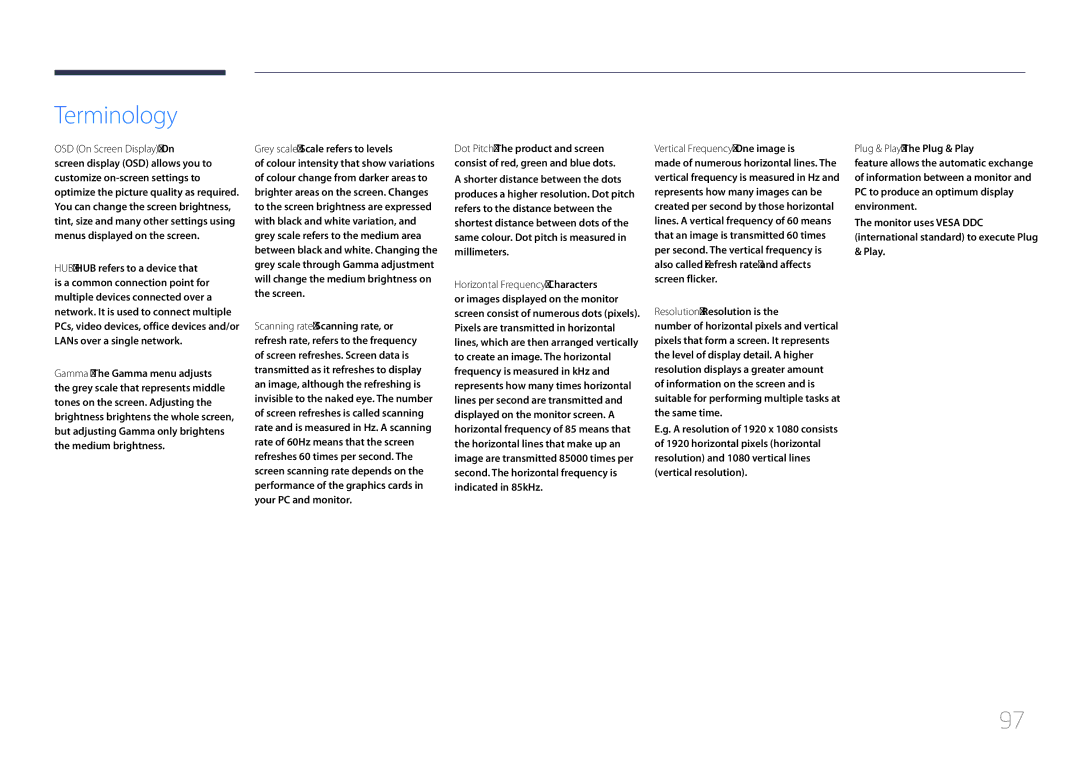LCD Monitor
Table of contents
Installing the Software
Specifications
Copyright
Before Using the Product
Safety Precautions
Securing the Installation Space
Precautions for storage
Symbols
Electricity and Safety
Cleaning
Power off the product and computer
Installation
Samsung
Operation
Product failure, an electric shock or fire may result
Output ports, etc
Page
Correct posture to use the product
Preparations
Cleaning cloth
Checking the Components
Components
Control Panel
Parts
JOG Button
Multi directional button that helps navigate
Direct Key guide
UP/DOWN Adjust Brightness, Contrast, Sharpness
Off
Return
Function Key Guide
Source Change
Power Off
Port
Reverse Side
Adjusting the Product Tilt and Height
Installation
Page
To lock an anti-theft locking device
Anti-theft Lock
Before Connecting
Connecting and Using a Source Device
Connecting and Using a PC
Connection Using the Hdmi Cable
Connecting to Headphones or Speakers
Connection Using the DP Cable
On the PC
Source is not set
Next, connect the power cable to the power outlet
Connecting the Power
STAND-REAR
Tidying Up the Connected Cables
Connecting a PC to the Product
Connecting the Product to a PC as a USB HUB
Utilizing the Product as a USB HUB
Setting Optimum Resolution
Driver Installation
Click Windows Driver
Select your product model from the list of models
Configuring Brightness
Screen Setup
Adjust the Brightness controlling the JOG button LEFT/RIGHT
Brightness
Adjust the Contrast controlling the JOG button LEFT/RIGHT
Configuring Contrast
Contrast
Selected option will be applied
Adjust the Sharpness controlling the JOG button LEFT/RIGHT
Configuring Sharpness
Sharpness
Configuring Game Mode
Game Mode
Samsung Magic Bright
Configuring Samsung Magic Bright
You can customize the brightness to suit your preferences
Movie Color Hdmi Black Level Custom
Adjust the tint of the screen
Configuring Color
Gamma Adjust the middle level of luminance
Color
Hdmi Black Level
Configuring the Hdmi Black Level Settings
Response Time
Configuring the Response Time
Standard / Faster / Fastest
Image Size
Screen Adjustment
Changing the Image Size
Change the picture size
AV mode
Position & V-Position
Configuring H-Position & V-Position
Selected option will be applied
PIP/PBP
Enable or disable the PIP/PBP Mode function
PIP/PBP Mode
Off / On
By moving the JOG button UP. Next, press the JOG button
Size
Screen is 1720 x 1440 width x height
Width x height
Position
PIP mode
Configuring Sound Source
Select the source for each screen
Configuring Source
DisplayPort / Hdmi 1 / Hdmi
Available in PBP modeSize
Hdmi
Digital output device is connected using the HDMI/DP cable
Configuring Image Size
These signals
Select the image size for sub-screen
Set the Image Size for each of the divided screens
Available in PBP modeSize PC mode
Image Size Apply 169 Cancel
Adjust the contrast level for sub-screen
Adjust the contrast level for each screen
Coordinating OSD
Configuring Language
Language
Set the menu language
Display Time
Configuring Display Time
Sec / 10 sec / 20 sec / 200 sec
Changing Transparency
Transparency
Set the transparency for the menu windows
Configuring Volume
Setup and Reset
Adjust the Volume controlling the JOG button LEFT/RIGHT
Sound
50%
Configuring Sound Mode
Configuring Select Sound
Eco Saving
Configuring Eco Saving
Off Disable USB Super Charging
Configuring USB Super Charging
USB Super Charging
Configuring PC/AV Mode
PC/AV Mode
DisplayPort Ver
Configuring DisplayPort Ver
Source Detection
Configuring Source Detection
Auto The input source is automatically recognized
Key Repeat Time
Configuring Key Repeat Time
Pressed
Configuring Off Timer
Off Timer
You can set the product to automatically turn off
――This option is only available when Off Timer is set to On
Configuring Turn Off After
Configuring Power LED On
Power LED On
Initializing Settings Reset All
Reset All
Information Menu and Others
View the current input source, frequency and resolution
Information
Displaying Information
Contrast
Brightness
Sharpness
Volume
Configuring Volume in the Initial Screen
Easy Setting Box
Installing the Software
Installing the Software
Removing the Software
Testing the Product
Troubleshooting Guide
Checking the Resolution and Frequency
Not Optimum Mode is displayed
Screen keeps switching on and off
Check the following
Adjust Brightness and Contrast
There is no sound
Volume is too low
Video is available but there is no sound
Ports Are not working
How can I change the frequency?
Adjust the resolution
Set the frequency on your graphics card
Monitor ,
Settings or Bios Setup on the PC
How do I set power-saving mode?
Appearance and Themes Display
Personalize
General
Specifications
Storage
Environmental conditions Operating
Power Indicator
PowerSaver
Power Consumption
Off
Standard Signal Mode Table
VESA, 1152 x
VESA, 1024 x
VESA, 1280 x
VESA, 1440 x
Contact Samsung World Wide
Appendix
800-10-7267 Samsung English
Samsung English
800-6225 800-0726-7864 English
800-2791-9267 800-2791-9111 English
000-405-437-33 English
0800-777-08
02-201-24-18
999
0818
70 70 19
800-7267
030-6227
08008 726 78 64 08008 Samsung Apel Gratuit
Lub +48 22 Koszt połączenia według taryfy operatora
011 321
Samsung 0800-726
+7-495-363-17-00
800-614-40
VIP care
10-800-500-55-500
0800
852 3698 English
021-56997777 08001128888
0120-363-905
94117540540
1800 3000 8282 Toll Free 1800 266 8282 Toll Free
Gsam
08000-7267864 16580
80-1000-12
18252273 English
444 77 Samsung 800 726
200
800-00-0077
9999
Samsung 726
1969
Not a product defect
Product damage caused by customers fault
Others
Correct Disposal
OSD On Screen Display On
Terminology
